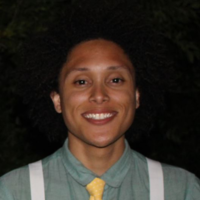More about Rumors of War
- All
- Info
- Shop

Contributor
Kehinde Wiley’s Rumors of War is a statue that stands to confront our racist past.
You probably know Kehinde Wiley without knowing that you know him. He painted Barack Obama’s Presidential portrait back in 2018. If you haven’t seen that painting at this point, where have you been? Wiley was chosen to paint the former President’s portrait because of his history of centering Black people, particularly men, in spaces where history has neglected them and told them that they don’t belong. That’s what he’s always done, and that’s what he's doing Rumors of War.
Commissioned by the Virginia Museum of Fine Arts, Rumors of War sits outside the museum, facing many other statues from the wrong side of history. Virginia was the capital of the confederacy during the Civil War, and Monument Avenue is home to many statues of horse-riding Confederate generals that were erected during Jim Crow. Though the Confederacy lost the war, the mere presence of those statues are a symbol of racist ideologies that are still present today. If those statues exist as a reminder, and a glorification, of the past, Rumors of War exists as a response or rebuttal that rises to meet those symbols of hatred and instead paint an accurate picture of the present, and a hopeful picture of the future.
In addition to including Black people in traditional white settings, Wiley is also known for using real people in his art. It hammers home the sentiment that he’s centering all of his people in spaces that they’ve been ignored in for so long. What’s a better way to do that by giving real people a platform to be seen? For instance, the young man on the horse in Rumors of War isn’t just a generic guy meant to be a symbol for an entire culture, he’s a living, breathing, real dude. His name is Najee Wilson, a fine arts muse who reached out to Wiley as a means of establishing a connection. Wiley answered, and the rest is history. (If there was ever a lesson in not being afraid to shoot your shot, this is it.)
Keeping consistent with the style present throughout all his work, Wiley took inspiration from Frederick Moynihan’s statue of J.E.B. Stuart, a white Confederate general. But instead of a bearded man in a military uniform surveying the land, Wiley’s statue features Najee Wilson, a young black man with dreads, some Nikes, and a hoodie. There’s something really beautiful about repurposing symbols hatred and bigotry and creating something as a direct response in opposition.
Where the statue of J.E.B Stuart is an example of our country’s inability to move forward, Wiley’s Rumors of War has a stance and demeanor that seem to convey a sense of confidence, and a feeling urgency. The horse is mid-gallop and Wilson’s body is turned as he looks behind himself, almost as to say “Let’s go,” as he leads us toward the future.
Sources
- Capps, Kriston. “Kehinde Wiley’s Anti-Confederate Memorial” The New Yorker. December 24, 2019. https://www.newyorker.com/culture/culture-desk/kehinde-wileys-anti-conf…
- Cruz, Araceli. “Virginia museum unveils Kehinde Wiley work in response to Confederate statues” The Guardian. December 10, 2019. https://www.theguardian.com/us-news/2019/dec/10/richmond-virginia-kehin…
- Rhodan, Maya. “'A Game Changer.' How a Painting of President Obama Broke the Rules” Time. February 14, 2018. https://time.com/5158961/obama-portrait-kehinde-wiley-amy-sherald-inter…
- Stamberg, Susan. “ ‘Rumors of War’ In Richmond Marks A Monumentally Unequal America” NPR. June 25, 2020. https://www.npr.org/2020/06/25/878822835/rumors-of-war-in-richmond-mark…












